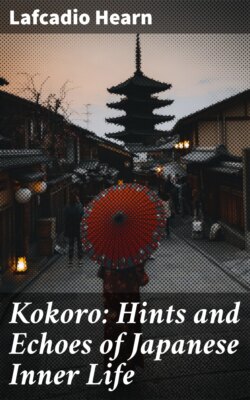Читать книгу Kokoro: Hints and Echoes of Japanese Inner Life - Lafcadio Hearn - Страница 19
На сайте Литреса книга снята с продажи.
VI
ОглавлениеKyoto, April 21.
The noblest examples of religious architecture in the whole empire have just been completed; and the great City of Temples is now enriched by two constructions probably never surpassed in all the ten centuries of its existence. One is the gift of the Imperial Government; the other, the gift of the common people.
The government's gift is the Dai-Kioku-Den—erected to commemorate the great festival of Kwammu Tenno, fifty-first emperor of Japan, and founder of the Sacred City. To the Spirit of this Emperor the Dai-Kioku-Den is dedicated: it is thus a Shinto temple, and the most superb of all Shinto temples. Nevertheless, it is not Shinto architecture, but a facsimile of the original palace of Kwammu Tenno upon the original scale. The effect upon national sentiment of this magnificent deviation from conventional forms, and the profound poetry of the reverential feeling which suggested it, can be fully comprehended only by those who know that Japan is still practically ruled by the dead. Much more than beautiful are the edifices of the Dai-Kioku-Den. Even in this most archaic of Japan cities they startle; they tell to the sky in every tilted line of their horned roofs the tale of another and more fantastic age. The most eccentrically striking parts of the whole are the two-storied and five-towered gates—veritable Chinese dreams, one would say. In color the construction is not less oddly attractive than in form—and this especially because of the fine use made of antique green tiles in the polychromatic roofing. Surely the august Spirit of Kwammu Tenno might well rejoice in this charming evocation of the past by architectural necromancy!
But the gift of the people to Kyoto is still grander. It is represented by the glorious Higashi Hongwanji—or eastern Hongwan temple (Shinshu). Western readers may form some idea of its character from the simple statement that it cost eight millions of dollars and required seventeen years to build. In mere dimension it is largely exceeded by other Japanese buildings of cheaper construction; but anybody familiar with the Buddhist temple architecture of Japan can readily perceive the difficulty of building a temple one hundred and, twenty-seven feet high, one hundred and ninety-two feet deep, and more than two hundred feet long. Because of its peculiar form, and especially because of the vast sweeping lines of its roof, the Hongwanji looks even far larger than it is—looks mountainous. But in any country it would be deemed a wonderful structure. There are beams forty-two feet long and four feet thick; and there are pillars nine feet in circumference. One may guess the character of the interior decoration from the statement that the mere painting of the lotos-flowers on the screens behind the main altar cost ten thousand dollars. Nearly all this wonderful work was done with the money contributed in coppers by hard-working peasants. And yet there are people who think that Buddhism is dying!
More than one hundred thousand peasants came to see the grand inauguration. They seated themselves by myriads on matting laid down by the acre in the great court. I saw them waiting thus at three in the afternoon. The court was a living sea. Yet all that host was to wait till seven o'clock for the beginning of the ceremony, without refreshment, in the hot sun. I saw at one corner of the court a band of about twenty young girls—all in white, and wearing peculiar white caps—and I asked who they were. A bystander replied: "As all these people must wait here many hours, it is to be feared that some may become ill. Therefore professional nurses have been stationed here to take care of any who may be sick. There are likewise stretchers in waiting, and carriers. And there are many physicians."
I admired the patience and the faith. But those peasants might well love the magnificent temple—their own creation in very truth, both directly and indirectly. For no small part of the actual labor of building was done for love only; and the mighty beams for the roof had been hauled to Kyoto from far-away mountain-slopes, with cables made of the hair of Buddhist wives and daughters. One such cable, preserved in the temple, is more than three hundred and sixty feet long, and nearly three inches in diameter.
To me the lesson of those two magnificent monuments of national religious sentiment suggested the certain future increase in ethical power and value of that sentiment, concomitantly with the increase of national prosperity. Temporary poverty is the real explanation of the apparent temporary decline of Buddhism. But an era of great wealth is beginning. Some outward forms of Buddhism must perish; some superstitions of Shinto must die. The vital truths and recognitions will expand, strengthen, take only deeper root in the heart of the race, and potently prepare it for the trials of that larger and harsher life upon which it has to enter.
